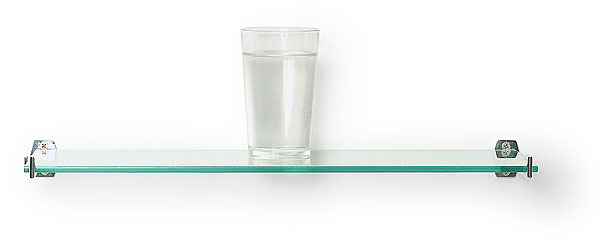An Oak tree
July 22, 2011
Michael Craig-Martin's 1973 sculpture appears to be a glass of water on top of a shelf. Craig-Martin, however, claims that the set is actually a tree. More specifically, an oak.
Below the art work is a poster with the following text about the work:
Q: To begin with, could you describe this work?
A: Yes, of course. What I’ve done is change a glass of water into a full-grown oak tree without altering the accidents of the glass of water.
Q: The accidents?
A: Yes. The colour, feel, weight, size …
Q: Do you mean that the glass of water is a symbol of an oak tree?
A: No. It’s not a symbol. I’ve changed the physical substance of the glass of water into that of an oak tree.
Q: It looks like a glass of water.
A: Of course it does. I didn’t change its appearance. But it’s not a glass of water, it’s an oak tree.
Q: Can you prove what you’ve claimed to have done?
A: Well, yes and no. I claim to have maintained the physical form of the glass of water and, as you can see, I have. However, as one normally looks for evidence of physical change in terms of altered form, no such proof exists.
Q: Haven’t you simply called this glass of water an oak tree?
A: Absolutely not. It is not a glass of water anymore. I have changed its actual substance. It would no longer be accurate to call it a glass of water. One could call it anything one wished but that would not alter the fact that it is an oak tree.
Q: Isn’t this just a case of the emperor’s new clothes?
A: No. With the emperor’s new clothes people claimed to see something that wasn’t there because they felt they should. I would be very surprised if anyone told me they saw an oak tree.
Q: Was it difficult to effect the change?
A: No effort at all. But it took me years of work before I realised I could do it.
Q: When precisely did the glass of water become an oak tree?
A: When I put the water in the glass.
Q: Does this happen every time you fill a glass with water?
A: No, of course not. Only when I intend to change it into an oak tree.
Q: Then intention causes the change?
A: I would say it precipitates the change.
Q: You don’t know how you do it?
A: It contradicts what I feel I know about cause and effect.
Q: It seems to me that you are claiming to have worked a miracle. Isn’t that the case?
A: I’m flattered that you think so.
Q: But aren’t you the only person who can do something like this?
A: How could I know?
Q: Could you teach others to do it?
A: No, it’s not something one can teach.
Q: Do you consider that changing the glass of water into an oak tree constitutes an art work?
A: Yes.
Q: What precisely is the art work? The glass of water?
A: There is no glass of water anymore.
Q: The process of change?
A: There is no process involved in the change.
Q: The oak tree?
A: Yes. The oak tree.
Q: But the oak tree only exists in the mind.
A: No. The actual oak tree is physically present but in the form of the glass of water. As the glass of water was a particular glass of water, the oak tree is also a particular oak tree. To conceive the category ‘oak tree’ or to picture a particular oak tree is not to understand and experience what appears to be a glass of water as an oak tree. Just as it is imperceivable it also inconceivable.
Q: Did the particular oak tree exist somewhere else before it took the form of a glass of water?
A: No. This particular oak tree did not exist previously. I should also point out that it does not and will not ever have any other form than that of a glass of water.
Q: How long will it continue to be an oak tree?
A: Until I change it.